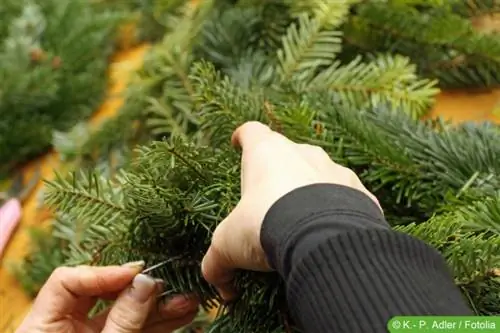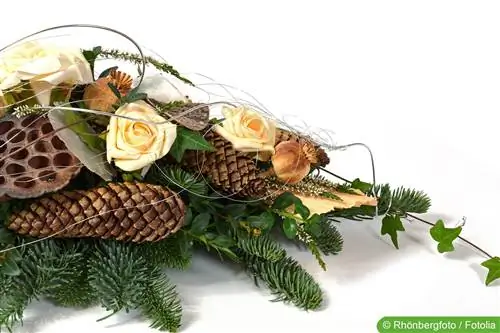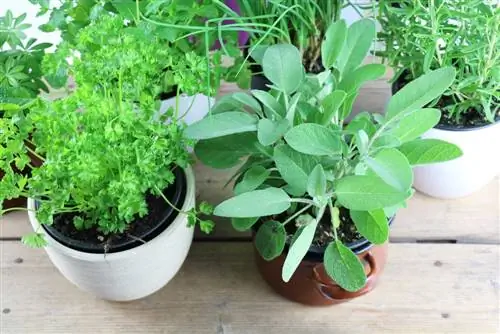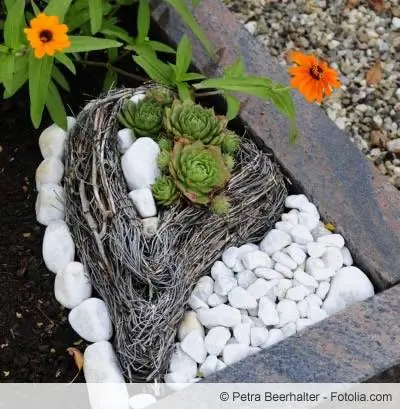- Author admin [email protected].
- Public 2023-12-17 03:39.
- Last modified 2025-06-01 06:48.
Lovingly decorating a resting place frees the bereaved from the apathy of deep grief. This positive effect is increased when relatives make their own grave arrangements and grave bouquets. Since a wide selection of prefabricated basic shapes and beautiful accessories can be discovered in specialist shops, a grave can easily be decorated with funeral flowers at any time of the year, not just on All Saints' Day and Sunday of the Dead. The following instructions explain how, with a little creativity, you can impressively express your appreciation for the deceased.
Instructions for a grave arrangement
The grave arrangement presented below is designed so that it can be arranged with both fresh and artificial flowers. In addition, the choice fell on a wicker basket and a vine wreath as basic shapes that can be used repeatedly in a modified form without the visitor to the resting place noticing.
Material requirements
- Wicker basket with foil insert and a width of approx. 18-20 cm, height 8 cm
- Wreath made of vines or brushwood with moss, maximum diameter 40 cm, height 8 cm
- 50 grams of flake moss natural
- 3 berry umbels in red with wire stem
- 1 brick plug-in mixture
- 5 roses with open flowers of 10 cm each - fresh or in silk
- 5 roses with closed flowers of 6 cm each - fresh or in silk
- 2 spirals of gold wire
- Amaranthus (foxtail) - fresh or prepared
- Prepared greenery or fresh shoots of thuja, ivy or fir
If you decide to use fresh flowers, support wire will still be needed to give the stems the stability required for attachment.
Instructions
Cut the floral foam so that it fills the wicker basket to just below the edge. Then cover the mixture thinly with moss to hide it from view. If the wicker basket has handles, these are cut off with pruning shears. Place the prepared basket in the wreath, creating a base for the decorative design of the inside of the wreath. The next step is to arrange the roses creatively. If necessary, shorten the stems with scissors so that the flowers protrude a maximum of 15 centimeters above the moss. Start in the middle, alternating buds and open flowers at a slight angle into the floral foam. The roses on the outer edge should rest diagonally on the vine wreath, which gives the basket additional stability. Arrange the red berry umbels and the foxtails in the gaps. The golden wire spirals lie all around the wreath, extending gracefully towards the middle, where the ends of the wire disappear into the brick.
Tip:
Take a look at the current cemetery regulations before purchasing the materials. Sometimes it is stipulated that only compostable materials may be used in order to align the shopping list accordingly.
Guide to a Funeral Bouquet
The symbolism of a grave bouquet as a final greeting to the deceased is particularly closely linked. In many regions, an ancestral wreath made of flowers and branches is used immediately before or after the funeral as an expression of condolence when a traditional wreath would go beyond the appropriate scope. On small resting places, such as urns or individual graves, a grave bouquet serves as an adequate decoration if a grave arrangement would appear too dominant.

On All Saints' Day and Sunday of the Dead, many cemetery statutes allow a mourning container to be used as decoration for a meadow grave, which must remain free in spring and summer in order not to hinder the regular mowing work by the cemetery administration employees. The following guide explains step by step how to make a grave bouquet yourself:
Material requirements
- Fir green, conifer branches, large leather fern leaves
- Pine cones, natural or sprayed in color
- binding wire
- Support wire
- Garden and wire scissors
- Decorative bow or cuff
A variety of seasonal flowers and plants can be considered for the color design. In winter, carpet berries, witch hazel, snow forsythia or corkscrew willow are recommended for decoration. Classic mourning flowers such as lilies, carnations, roses or gerberas can be considered for the summer bouquet. Sea lavender, ears of wheat or pussy willows come into their own here.
Instructions
So that the actual binding work goes without interruption, all flower stems are wrapped in a spiral with a support wire in preparation. Under no circumstances should the plant tissue be damaged. The same applies to the cones, which are wrapped with wire in the middle, with the tapered end of the wire being at least 10-15 centimeters long. This gives them the necessary stability so that they can be added to the bouquet from above if necessary. Now hold the greenery together in one hand so that the long branches are on the outside and the short branches are in the middle. This creates the basic framework for the desired flat arrangement. The creative phase of design then begins. Cones, fresh and dried flowers, wheat ears and other accessories are combined in such a way that the greenery serves as a contrasting background. Use wire cutters to cut the stems to a uniform length and bend them upwards. In the last step, the lower end of the bouquet is embellished. To do this, cut several fir branches to approx.5 centimeters long. Working the other way around, tuck the greenery into the end of the bouquet so that it covers the curved wires. Ideally, a bow in a matching color is tied around it.
Condolence bouquet for the vase
If the grave bouquet has a place in the vase, a round arrangement is recommended. The materials and preparatory work correspond to the instructions for the lying version.

The use of a heart cuff is also recommended. Follow these steps:
- Take the chosen main flower in your hand
- Right-handed people take this in their left hand, left-handed people take it in their right hand
- During design, the thumb fixes the last element created
- Arrange all other accessories around and fill with green
- Fir green, conifer fronds or green leather fern form the outer edge
- Use scissors to cut all the stems to a uniform length and tie them together with wire
- The stems of fresh flowers are cut at an angle so that they can absorb water better
Last but not least, pull the heart cuff over the funeral bouquet and tie it at the bottom with raffia.
Tip:
So that the grave bouquet has a harmonious shape, the container is examined with an outstretched arm in order to make corrections in good time.
Grave bouquet for those in a hurry
There is not always enough time to dedicate extensive time to arranging a flower arrangement or opulent container. If you have the right materials at hand, you can create a funeral bouquet in just a few minutes. The components are not tied together, but are placed directly into a vase filled with earth and sand.
Material list
- Vase filled with earth and sand mixture
- Ball with artificial fir branches
- Wooden sticks
- Christmas roses or other silk flowers with stems
- White rattan ribbon with wooden beads
- Decorative hearts with wire
Place the pine ball on the vase. The necessary support is provided by 3-4 wooden sticks, which are pushed through the ball into the ground. Simply cut off the ends that are still visible. Now take the silk flowers and stick them diagonally into the vase in a circle around the pine ball. The rattan ribbon is draped criss-cross over the ball. You also push the ends of the band into the ground. Finally, add the decorative hearts to the bouquet by sinking their wire into the soil and sand mix, thereby maintaining stability. If the bouquet is used to decorate a grave during Advent, simply swap the decorative hearts for small Christmas balls attached to a wooden stick.
Conclusion
Designing beautiful grave decorations is no longer just the responsibility of florists. Thanks to a variety of purchasing sources, you can easily make a grave arrangement and a grave bouquet yourself. Sometimes your own garden already provides all the important components, such as greenery, pine cones, flowering branches or flowers. Then all that's missing are working materials such as floral foam and wire as well as practical instructions to create individual funeral floristry on your own. For the tormented soul of the bereaved, the creative work also functions as active mourning work. Anyone who would like to express their condolences with a flower arrangement or container will appreciate the cost savings.






